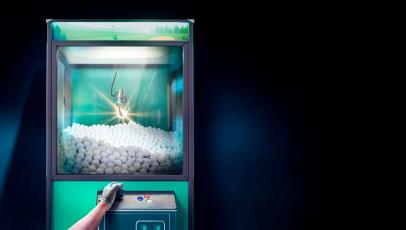golf ball hot list
Urethane versus non-urethane golf balls: What our robot test revealed

Our robot test found that urethane cover golf balls spin 30 to 50 percent more than non-urethane golf balls on 45-yard pitch shots.
Mike Ehrmann
In our robot testing, conducted by the independent clubfitting chain Cool Clubs, golf balls with urethane covers preferred by tour pros averaged 30 to 50 percent more spin on a 45-yard pitch shot than balls with non-urethane covers. In yardage terms, that could mean as much as 13 more feet of rollout with a non-urethane ball, affecting your ability to stop the ball near the hole.
What does less check on a pitch shot really mean for an average golfer? When we reference that 13-foot difference, we’re basing this on a flat green, using the simulation software created by Foresight Sports, manufacturer of the GCQuad launch monitors. If a green has some slope on it, missing that ideal landing spot for a chip shot with a non-urethane cover ball could lead to misses of even more. Conversely, if a golfer doesn’t own a certain deftness to his or her short game, or if the stock short-game shot is almost always a bump-and-run shot, then a ball with a non-urethane cover might provide sufficient performance.
When Golf Digest ran a test with average golfers, less than half could tell the difference between a non-urethane cover ball and a urethane cover ball. Still, 93 percent of the better players (less than a 5-handicap), saw the spin advantage of urethane-cover balls, and many said they had to change their shot type to get the non-urethane balls to stop close to the hole. Urethane covers have the capacity to check thanks to a generally softer material that the grooves on your wedge can grab compared to an ionomer or Surlyn cover material that leads to the ball sliding up the face. A ball with a urethane cover allows for a more aggressive chipping or pitching motion on shorter shots to produce the spin that gets the ball to check.
That same kind of shot with a non-urethane cover ball will produce a higher, faster flight, and the ball will tend to bounce forward rather than spin. Of course, it’s also true that a player could control non-urethane cover balls by hitting a different type of shot, but as many of the low-handicap golfers that participate in our testing have told us, it’s simply harder to hit those shots and calculate the unpredictable rollout of some non-urethane cover balls.
Now, do all non-urethane cover balls woefully underperform compared to urethane cover balls? No. In our testing, some non-urethane cover balls might have 5 to 10 percent less spin than the lowest-spinning urethane cover balls. We even saw instances of a non-urethane ball producing marginally more spin than a urethane ball. But here's the thing: The vast majority of the time, non-urethane balls had a standard deviation in spin that was on average 50 percent higher than that of the urethane balls, and in some cases was double or triple. In other words, the best non-urethane balls could generate spin but not the highest and not consistently.
In the end, we still think the advantages of urethane cover balls are consistent, reliable and proven. Regardless of your ability, urethane cover balls provide the greatest opportunity to max out the performance potential of any short-game shot, all without sacrificing the kind of distance any player would notice.

